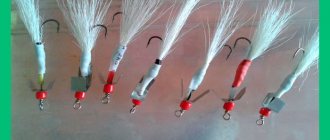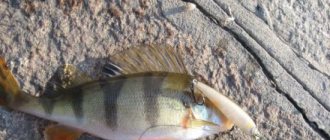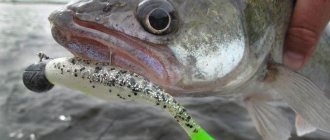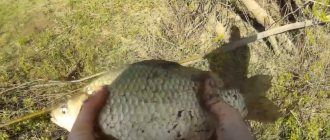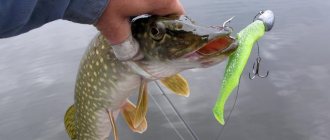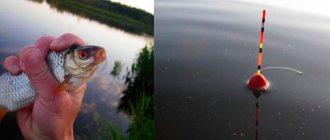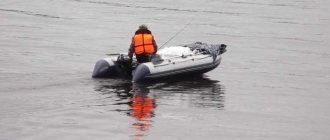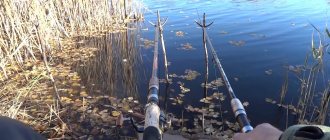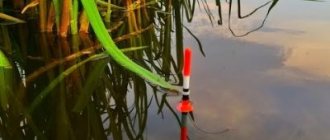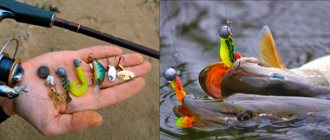A little about jig
At the beginning of the conversation, we will clarify for readers what the fishing method is, so named for its similarity with the American dance - jig.
Attention! Jig is a method of spinning fishing in which a front-loaded bait makes stepwise movements near the bottom or, quite rarely, in the water column.
They fish with a jig both from the shore and from a boat, using not only silicone, as some anglers think, but also using other baits:
- foam fish;
- mandul;
- front-loaded turntables;
- oscillators with a forward-shifted center of gravity;
- rattlin type wobblers.
When jigging, the bait moves along a wave-like path near the bottom
Types of postings
Jig fishing, when properly mastered, offers many variations of fishing that not only diversify your fishing style, but also allow you to choose the most effective method for specific fishing conditions. Below we provide a brief description of each of them.
Simple stepped
This fishing technique is recommended for beginner horsemen due to its ease of execution and the ability to quickly master it. It is performed in the following sequence:
- We cast to the selected point.
- We wait until the bait touches the bottom. This moment can be noticed by the tip of the spinning rod moving upward and the braid sagging.
- We select the slack of the fishing line and make 2-3 turns with the reel.
- We pause until the bait touches the bottom again.
- We alternate reelings with pauses until the bite occurs or the bait approaches the boat.
On a note! If the rotations are done at the same speed and the same number of repetitions, you will notice that the length of the pause changes. An increase indicates that the fishing spot is deepening, a decrease indicates that the bait is running aground.
Short step
This type is similar to the classic, but more rhythmic. Wiring is carried out with one revolution of the coil at high speed. This is usually how active perch is caught, but pike perch and pike perch are also not against this type of bait presentation.
American
This type of wiring is similar to the classic one, the difference is that the step is obtained not as a result of winding with a reel, but as a result of working with the tip of a spinning rod. After touching the bottom, the angler jerks the rod up several times, then picks up the slack in the line with the reel.
By varying the frequency and height of throwing the bait, a spinner can force the most passive fish to bite
Wiring for demolition
On reservoirs with a pronounced current, wiring for demolition is practiced. It is somewhat similar to the American one, but has some differences.
The technique is as follows:
- After casting and touching the bottom, we swing the rod upward.
- The bait rises and is carried away by the current.
- After it touches the bottom, we remove the slack in the fishing line.
- We repeat tosses, pauses and rewinds.
Aggressive
This technique is aimed mainly at catching trophy pike. It consists in combining the separation of the bait from the bottom with simultaneous fast reeling. In this case, the step turns out to be sharper and more amplitude, which has a good effect on the toothy predator.
Uniform
The technique follows from the name - we lead the bait with a uniform reel without pauses or jerks. This type of wiring is best suited for fishing with spinners or silicone with a pronounced animation of its own.
Pendulum
It differs in that it works with the rod in two directions: up and down. Raise the rod after touching the bottom, lower it after reeling. In this way, the amplitude is increased, trying to go around various underwater obstacles.
Dotted
In this method, the bait is baited with short, almost twitching twitches with the tip of the spinning rod with a small amplitude of 5–10 centimeters. In this case, the rod is held with the tip down, trying to practically drag the silicone along the bottom. The main fan of this technique is pike perch.
Drawing
The method is applied to the “diverter leash” equipment. Drawing is carried out by uniform drawing without separating the sinker from the bottom. In this case, the bait moves at the set height - from ten to thirty centimeters.
When fishing with a retractable leash, a small wobbler is often used as bait.
Classic jigging process
First you need to cast. The bait should sink smoothly and freely to the very bottom of the reservoir. This will be visible from the sagging line. The spinning rod should be held at an angle of 45 degrees relative to the water. You need to make about 4 turns of the reel handle and wait until the bait falls to the bottom again. After this, you need to repeat the winding again.
An angle of 45 degrees is necessary for effective hooking. Experts recommend not to exceed a right angle, since not every top of the spinning rod is able to withstand the loads during the process of hooking “over the head” . The bait is detonated using a spinning rod with a change in its position. The top of the rod is directed after casting to the place where the bait splashes down in a parallel position relative to the surface of the reservoir.
The fisherman takes out the slack in the fishing line, and the spinning rod is moved from a parallel position to a perpendicular one. It is necessary to wait for the bait to fall to the bottom (during the fall, the rod must be moved to 45-60 degrees, while picking up any slack in the fishing line) and repeat these steps again.
This fishing technique has a lot of advantages, which include quick and sharp detonation of the bait from the bottom. Thanks to its high acceleration, the bait can create vibrations in the water, which in turn will attract fish even at a great distance. However, using this method, it is quite difficult to control the bait when retrieving and often contact with it is lost.
The bite is detected by changes in the tension of the braid and the tip of the rod. The hook must be performed in a timely manner, immediately after the blow or the first poke. Almost 60% of bites occur when the bait is lowered to the bottom, so you need to carefully choose a balanced rig that will provide maximum free fall time on a short step. It is also necessary in this case not to cause harm to the gear itself.
It is also necessary to mention that when fishing with a jig downstream, you should use a smaller weight of the sinker than when fishing against the flow of water.
Search fishing
Exploratory fishing involves quickly fishing a large area of a reservoir, the purpose of which is to identify the largest concentration of fish. For the most part, search fishing is used on an unfamiliar body of water and is characterized by such an expression as “take more and throw further.” That is, the fisherman takes a weighted jig head and casts it as far as possible. Next, the classic step is carried out at an accelerated pace.
After discovering a promising place, the heavy jig head is replaced with a light one, with the help of which a soft presentation of the bait is achieved. Further, the pace of the retrieve decreases, and the bait itself, after detonation, should reach the bottom in about 10 seconds.
Spinning for jig
In jig fishing, choosing the right rod is especially important. The remaining components of the gear are not so important. Let's first consider the criteria for how to choose a good stick, then present the rating of spinning rods in different price categories.
Build
To successfully fish with the jig method, you need to choose a fast or extra fast stick. Experienced spinning anglers call the blanks of such rods “evil” or “ringing.” It is these rods that best transfer into your hand everything that happens to the bait under water.
In this case, the tip of the spinning rod can be soft, transmitting the slightest touch of the bait to the bottom, grass, or the most gentle bite. Often the tips of jig blanks are made not hollow, but full-bodied. Such inserts into the form are called solid, in contrast to the usual hollow ones, called tubular.
Attention! A full-bodied tip is chosen for better visual perception, a tubular tip for better tactile sensitivity.
Some manufacturers paint spinning tips white for better visualization.
Length
If you do not fish from a large boat or yacht, then the choice of your boat spinning rod should meet the mobility criterion, because often the space on the boat is very limited.
The most popular sizes for boat fishing are six- or seven-foot (180–210 centimeters) blanks. They allow you to cast the bait far enough and easily control the rod when fishing for a trophy.
Test
What kind of jig heads are there for pike perch?
The spinning rod test for boat fishing depends on two factors:
- depth at the fishing point;
- flow speed in a section of the river.
Naturally, the deeper the river and the stronger its current, the more powerful the stick you will need. In this regard, it is best to find information about the conditions of the specific area of the reservoir where you are going to fish before purchasing.
For example, for fishing in a reservoir without a current and with a depth of 4–5 meters, a medium light spinning rod with a test weight of 4–21 grams will be enough. At the same time, jigs in the flow of a deep river may require a heavy stick, 15–40 grams - according to the test load.
Rod type
The choice of rod type does not play a special role in the success of fishing. This is rather a personal preference of each spinner. Most people fish with regular rods and a spinning reel. But if you're a fan of the casting rod and baitcasting reel, that's up to you.
A casting spinning rod for a baitcasting reel is distinguished by the presence of a kind of “trigger” in the area of the reel seat
Rating
Below we present a rating of rods that will help you choose the best spinning rod for jigging.
Maximus WorkHorse-X
We start the review with a budget “workhorse” from the Maximus company. This spinning rod, costing from two and a half thousand rubles, has well-deserved popularity due to its technical characteristics and reliability.
The following are also noted for the better:
- versatility;
- availability;
- high quality workmanship.
The spinning rod has a bright design, which is the hallmark of the brand.
The Maximus WorkHorse-X line contains various mojels in test and size. For boat jigs, models with a length of 180–210 centimeters with tests ranging from ultralight (1–8 grams) to medium hard (15–40) are especially suitable.
St.Croix Legend Xtreme
One of the most popular elite spinning rods is this 2012 model. Over the past time, spinning has not only not lost its fans, but has also significantly increased them.
Although the price of the stick is steep (it is about five hundred US dollars), the product is worth it. What can I say if the manufacturer gives a lifetime warranty on the rods?
An ergonomic handle and an elegant blank design are the external features of the spinning rod.
Another feature of the spinning rod is the use of two different types of carbon in the manufacture of the blank: the upper and lower legs differ in this indicator. This innovation reduced the overall weight by almost thirty percent.
Judge for yourself! Spinning St. Croix Legend Xtreme LXS70MHF2 is 2.13 meters long with a dough of 10.5–21 grams and weighs only 109 grams!
Major Craft Restive
Next in the review we will present the Major Craft Restive spinning rod. It is in the middle price niche, mostly asking about nine thousand rubles for it as of mid-2021.
Most of the sticks in this line are designed for shore jigging, but two models are 206 centimeters long. This is a medium-light spinning rod with a test weight of 6–21 grams and a medium-heavy one with a test weight of 8–32.
Despite the fact that the manufacturer declares the spinning rod as a universal one, it is mainly bought by jig fans, and a little less often by fans of twitching wobblers. This is facilitated by the extra fast action of the blank and the use of Fuji Alconite guides, which allow the line to slide without encountering friction.
Some price reduction is due to the use of a simple reel seat model and an economical cork handle
Pontoon 21 Gad Harrier
A good line of fast spinning rods is presented by the subsidiary of Pontoon21 under the GAD brand. One of the best examples of products from this company is the Harrier line.
Harrier spinning rods work well with both wobblers and jig baits. The rods are of high quality. At the same time, you can buy a stick for a very reasonable price of just over five thousand rubles.
The bright orange color of the blank makes the spinning rod stand out from others
Attention! Among the products of the Pontoon21 company there are also more budget poles. For example, GAD Gancho and GAD Fair.
Reels
The second most important element of jig tackle is the reel. It should be immediately noted that, in contrast to the same twitching, the requirements for this element are slightly lower. When jigging, there are no sharp jerks that quickly wear out the mechanism and require perfect winding. Therefore, when choosing a specific model, pay attention to the following features:
- size –2500–3000 according to Shimano-Daiwa;
- at least four bearings;
- gear ratio - approximately 5.0:1;
- metal spool.
The main condition for choosing a reel is balance with the spinning rod and ease of use
Cord or fishing line
Here the answer is clear: only braided cord. When fishing at long distances and depths, the sensitivity of the gear comes to the fore, and in this regard, braid is superior not only to nylon monofilament, but also to the increasingly popular fluorocarbon. As for the diameter, it should be matched to the rod using the so-called line test.
The lure test shows how much weight we can cast, the line test shows how much the rod can withstand when the line is overloaded
Biting and fishing
Pike perch bites can be divided into three types:
- bite with a blow;
- hanging (if he takes the bait after him);
- chasing after the slack line (when the pike perch, after hitting the bait, goes forward with it, this is how a large pike perch usually bites).
Hooking should follow immediately after detecting disturbances in the movement of the bait; when biting with a slack line, hooking with the rod is done while simultaneously reeling in the fishing line . After hooking, you take the pike perch to an average distance (about 10-15 m), trying to keep it in the upper layer of water (up to 2 meters from the surface). The friction is adjusted to approximately 50% of the breaking load of the fishing line.
Lures
Jig fishing from a boat is carried out using different baits:
- silicone;
- foam;
- mandulas;
- wobblers;
- spinners.
Silicone
Silicone fish, or rubber, are currently represented by the following modifications:
- vibrotail,
- twister,
- slug,
- worm,
- fantasy "krakozyabry".
The choice of one largely depends on the preferences of the fisherman. But from a boat they mainly fish with stubborn vibrotails with or without weights.
Attention! Silicone baits can be “edible” due to the addition of some attractant during production.
Foam rubber
Foam rubber fish appeared a little earlier than silicone. They are mainly used for pike perch in installation with a Cheburashka load and are equipped with an offset hook or double.
Spinners often make foam fish themselves and paint them in different colors.
Mandula
A typical bait for pike perch is for the most part also made by our Samodelkins from fishing. In terms of catchability, it can surpass the most sophisticated edible rubber.
Mandulas are made from various types of synthetic materials. Sometimes regular slippers are used
Spoons
Various spoons are suitable for jig fishing. An important condition is the shift of the center of gravity to the front. This circumstance allows us to carry out the jig wiring we need with these baits.
The jig spoon has a small lead weight in front
Wobblers
Regular minnows or shad are not suitable for jigging. But rattlins that have sufficient weight are quite suitable. They are used for catching predators in winter or from a boat vertically using vertical lures, but they are also suitable for our case.
Rattlins are distinguished by the absence of a blade, fastening to the back and increased weight
How to fish with a jig
The jig fishing technique includes the following steps:
- Selection of suitable terrain. The best places for jig fishing are areas of reservoirs with sharp changes in depth. In addition, it is very important that the depth along the entire fishing line is from five to twelve meters.
- Casting To do this, you need to place the bait on a fishing line and lower it to the bottom of the reservoir. The line should be taut.
- Take a spinning rod and make a few spins with the reel.
- By the tension of the fishing line, determine when the bait will fall to the bottom again and reel in again. In this case, you need to keep the tip of the fishing rod parallel to the pond.
- When a fish bites, the tip of the fishing rod will begin to twitch, and the line will tighten even more.
- It is necessary to hook immediately after the “push” of the fish.
- You need to fish carefully , since it is not always immediately clear what kind of fish was hooked. You should definitely use a refill.
